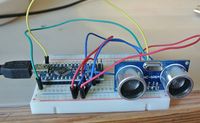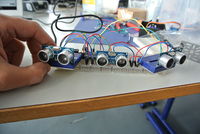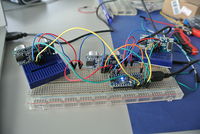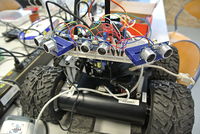HC-SR04 Ultrasonic Sensor Distance Measuring Module
Jump to navigation
Jump to search
HC-SR04 Ultrasonic Sensor Distance Measuring Module
- Model: HC-SR04 - Color: Blue + Silver - Working voltage : 5V(DC) - Static current: Less than 2mA. - Output signal: Electric frequency signal, high level 5V, low level 0V. - Sensor angle: Not more than 15 degrees. - Detection distance: 2cm~450cm. - High precision: Up to 3mm - Mode of connection: VCC / trig(T) / echo(R) / GND - Module Working Principle: - Adopt IO trigger through supplying at least 10us sequence of high level signal - The module automatically send eight 40khz square wave and automatically detect whether receive the returning pulse signal - If there is signals returning, through outputting high level and the time of high level continuing is the time of that from the ultrasonic transmitting to receiving
A lire
- http://www.arduino.cc/cgi-bin/yabb2/YaBB.pl?num=1272177425
- http://iteadstudio.com/application-note/arduino-library-for-ultrasonic-ranging-module-hc-sr04/
Arduino
Simple
// load the library for HC-SR04 http://iteadstudio.com/application-note/arduino-library-for-ultrasonic-ranging-module-hc-sr04/
// Remark: change the “WProgram.h” reference to “Arduino.h” in files "Ultrasonic.h" and "Ultrasonic.cpp" and everything will be fine
#include "Ultrasonic.h"
// Sensor VCC pin connected to Arduino pin 5V
// Sensor GND pin connected to Arduino pin GND
// Sensor TRIG pin connected to Arduino pin 12
// sensor ECHO pin connected to Arduino pin 13
Ultrasonic ultrasonic(12,13);
void setup() {
Serial.begin(9600);
}
void loop()
{
Serial.print(ultrasonic.Ranging(CM));
Serial.println(" cm");
delay(100);
Serial.print(ultrasonic.Timing()); // Distance = ((Duration of high level)*(Sonic :340m/s))/2
Serial.println(" ms");
delay(100);
}
With 3 Ultrasonic + Servo
/*
* UltraSonic Scanner
*
* output values from a ultrasonic sensors array in a NMEA 0183 sentence (ie formatted message)
*
* $USDIS,LEFT_DISTANCE_IN_CM,CENTER_DISTANCE_IN_CM,RIGHT_DISTANCE_IN_CM,SERVOPOS*CHECKSUM[CR][LF]
*
* TODO Calcutate checksum (always 00)
*/
#include "Ultrasonic.h"
#include <Servo.h>
Servo myservo; // create servo object to control a servo
// a maximum of eight servo objects can be created
Ultrasonic ultrasonicCenter(12,13);
Ultrasonic ultrasonicRight(10,11);
Ultrasonic ultrasonicLeft(6,7);
int servoPos = 90; // variable to store the servo position
int servoIncr = 10; // variable to store the servo increment
const int MINSERVOPOS=55;
const int MAXSERVOPOS=125;
void setup() {
Serial.begin(4800);
myservo.attach(3); // attaches the servo on pin 9 to the servo object
}
void loop() {
Serial.print("$USDIS,");
Serial.print(ultrasonicLeft.Ranging(CM));
Serial.print(",");
Serial.print(ultrasonicCenter.Ranging(CM));
Serial.print(",");
Serial.print(ultrasonicRight.Ranging(CM));
Serial.print(",");
Serial.print(servoPos);
Serial.print("*");
Serial.print("00");
Serial.print("\r\n");
myservo.write(servoPos); // tell servo to go to position in variable 'pos'
servoPos=servoPos+servoIncr;
if(servoPos<MINSERVOPOS || servoPos>MAXSERVOPOS) servoIncr=-servoIncr;
delay(100);
}
byte calcChecksumBuf(byte checksum, byte buf[], int i, int len){
for(;i<len; i++){
checksum=calcChecksum(checksum,buf[i]);
}
return checksum;
}
byte calcChecksum(byte checksum, byte c){
if ( c == '$' ) return 0;
if ( c != '\r' && c != '\n' && c != '*' ) {
checksum ^= c;
}
return checksum;
}



